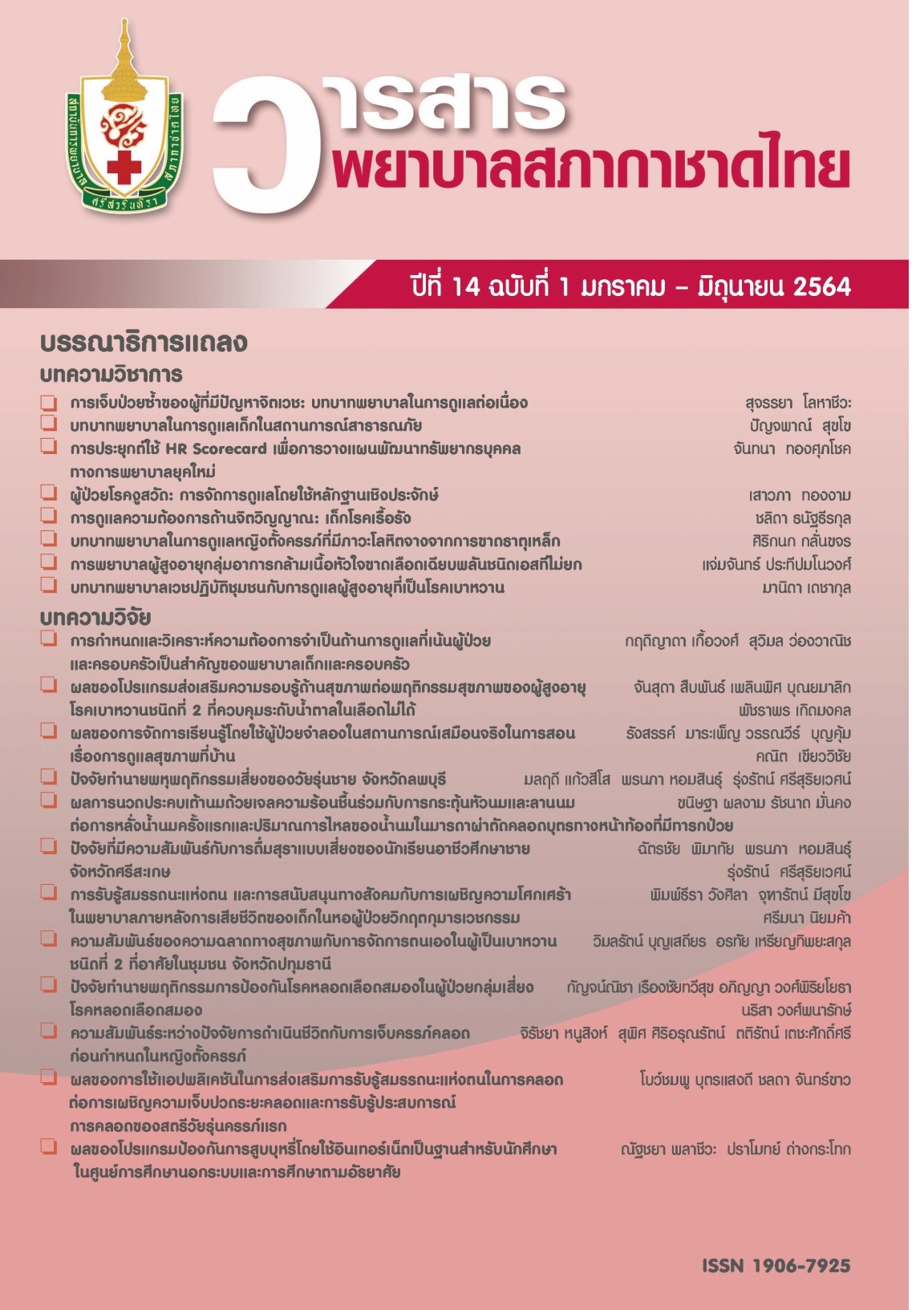Effect of Using an Application for Enhancing Childbirth Self-efficacy to Cope with Labor Pain and Perception of The Childbirth Experience of Nulliparous Pregnant Adolescents
Keywords:
application, childbirth self-efficacy, labor pain coping, adolescent, childbirth experienceAbstract
This Quasi-experimental research (two group posttest only design) aimed to evaluate the effect of using an application for enhancing childbirth self-efficacy to cope with the labor pain and perception of the childbirth experience of nulliparous pregnant adolescents. Participants were 13-19 year old nulliparous pregnant women with a gestational age of between 34 and 35 weeks that attended the Antenatal Care Unit of the Queen Savang Vadhana Memorial Hospital. There were 80 mothers, 40 each in the control group and experimental group. Participants in the experimental group were assigned to use the application, whereas the control group received routine standard care. The application was used as an instrument in conducting the study, which was based on Bandura’s self-efficacy theory. The labor pain coping behavior observation form and perception of childbirth experience questionnaire, which had Cronbach’s alpha coefficient at .92 and .90 respectively, were used to collect the data. Descriptive statistics and Independent T-test were used for analyzing the data.
The results reveal that mothers in the experimental group had significantly higher mean scores on coping with the labor pain and perception of childbirth experience than mothers in the control group (t = 5.968, p < .001; t = 8.075, p < .001 respectively).This demonstrates that the application could effectively be used to increase childbirth self-efficacy to cope with the labor pain and perception of childbirth experience among nulliparous pregnant adolescents.
References
2. Department of Health. National strategy of prevention and solution in adolescent pregnancy problem A.D. 2017-2026 on Act for prevention and solution of the adolescent problem, A.D. 2016 [Internet]. Bangkok: Department of Health; 2017 [cited 2018 May 9]. Available from: https://rh.anamai.moph.go.th/all file/index/action plan/the National-Strategy–on-Prevention-and Solution-Adolescent Pregnancy (in Thai)
3. Lowdermilk DL, Perry SE, Casion K, Alden KR. Maternity & women’s health care. 11th ed. St. Louis: Elsevier; 2016.
4. Sauls DJ. Promoting a positive childbirth experience for adolescents. JOGNN 2010;39(6):703-12.
5. Dick-Read G. Childbirth without fear. 5th ed. New York: Harper & Row; 1984.
6. Howie L, Rankin J. Pain relief in labour. In: Rankin J, editor. Physiology in childbearing
with anatomy and related biosciences. 4th ed. Edinburgh: Elsevier; 2017. p. 399-410.
7. Asl BMH, Vatanchi A, Golmakani N, Najafi A. Relationship between behavior indices of pain during labor pain with pain intensity and duration of delivery. Electron Physician 2018;10(1):6240-48. doi: http://dx.doi.org/10.19082/6240.
8. Schwartz L, Toohill J, Creedy DK, Baird K, Gamble J, Fenwick J. Factors associated with childbirth self-efficacy in Australian childbearing women. BMC Pregnancy Childbirth 2015;15:29. doi:10.1186/s12884-015-0465-8.
9. Bell AF, Anderson E. The birth experience and women’s postnatal depression: a systemic review. Midwifery 2016;39:112-23. doi:10.1016/j.midw.2016.04.014.
10. Rastegari L, Mohebbi P, Mazlomzadeh S. The effect of childbirth preparation training classes on perceived self-efficacy in delivery of pregnant women. J Adv Med Biomed Res [Internet]. 2013 [cited 2019 Aug 9];21(86):105-15. Available from: http://zums.ac.ir/journal/article-1-2003-en.html
11. Sanchez-Cunqueiro MJ, Comeche MI, Docampo D. On the relation of self-efficacy and coping with the experience of childbirth. J Nurs Educ Pract 2018;8(6):48-55. doi: 10.5430/jnep.v8n6p48.
12. Bandura A. Self-efficacy and health behaviour. In: Baum A, Newman S, Weinman J,
West R, McManus C. editors. Cambridge handbook of psychology, health and medicine. Cambridge: Cambridge University Press; 1997. p. 160-61.
13. Chirawattanasate W. The digital generation kinds within social media society and social learning. Journal of education futurology [Internet]. 2017 [cited 2017 Aug 9];1(1):1-10. Available from: https://nakhonnayok.dusit.ac.th. (in Thai)
14. Farrah AA, Abu-Dawood AK. Using mobile phone applications in teaching and learning process. Int J Res Engl Educ 2018;3(2):48-67. doi:10.29252/ijree.3.3.48.
15. Jongruangsap K. Behavior and factors affecting decision on listening to music via mobile application in teenage audiences [Thesis]. Bangkok: Bangkok University; 2015. (in Thai)
16. Burns N, Grove SK. The practice of nursing research conduct, critique and utilization. 5th ed. Philadelphia: Elsevier Saunders; 2005.
17. Baosoung C. The effects of planned instruction and touching on anxiety level and coping behavior during labor [Thesis]. Bangkok: Mahidol University: 1984. (in Thai)
18. Subprasert Y. Effects of nursing care using nonpharmacological technique of pain relief on pain coping behaviors during delivery, duration of labor and perception of childbirth experience in primiparas [Thesis]. Bangkok: Chulalongkorn University; 1998. (in Thai)
19. Panthongchai S, Yusamran C, Pahuwattanakorn W. Effects of self-efficacy enhancing
program during childbirth on pain coping behavior in nulliparous women. Kuakarun Journal of Nursing 2017;24(1):130-46. (in Thai)
20. Sercekus P, Baskale H. Effects of antenatal education on fear of childbirth, maternal self- efficacy and parental attachment. Midwifery 2016;34:166-72. doi:10.1016/j.midw.2015.
11.016.
21. Howarth AM, Swain NR. Skills-based childbirth preparation increases childbirth self-efficacy
for first time mothers. Midwifery 2019;70:100-5. doi:10.1016/j.midw.2018.12.017.
22. Tabaghdehi MH, Keramat A, Kolahdozan S, Shahhosseini Z, Moosazadeh M, Motaghi Z. Positive childbirth experience: a qualitative study. Nursing Open 2020;7:1233-8. doi: 10.1002/nop2.499.
23. Nilsson L, Thorsell T, Wahn EH, Ekstrom A. Factors influencing positive birth experience of first-time mothers. Nurs Res Pract 2013;2013:1-6. doi: 10.1155/2013/349124.
Downloads
Published
Issue
Section
License
เนื้อหาบทความหรือข้อคิดเห็นต่างๆ ในวารสารพยาบาลสภากาชาดไทยนี้ เป็นความคิดเห็นของผู้เขียนบทความ ไม่ใช่ความเห็นของกองบรรณาธิการ หรือสถาบันการพยาบาลศรีสวรินทิรา สภากาชาดไทย






